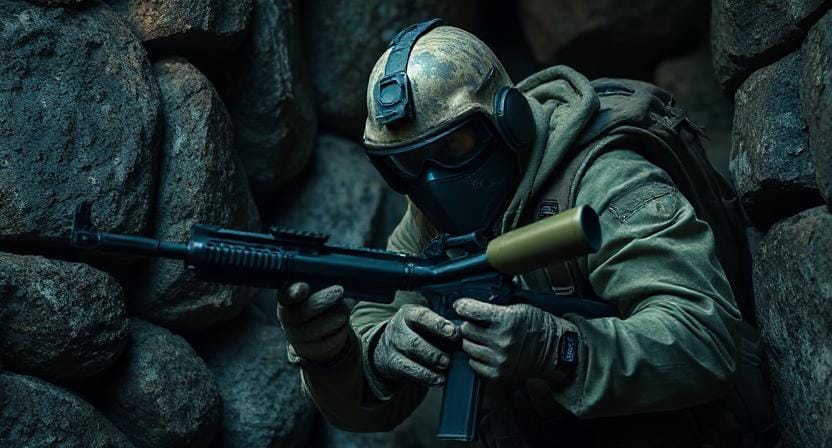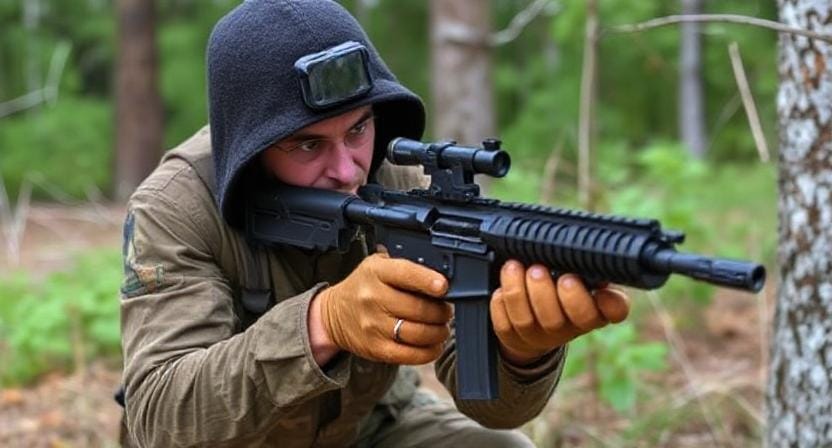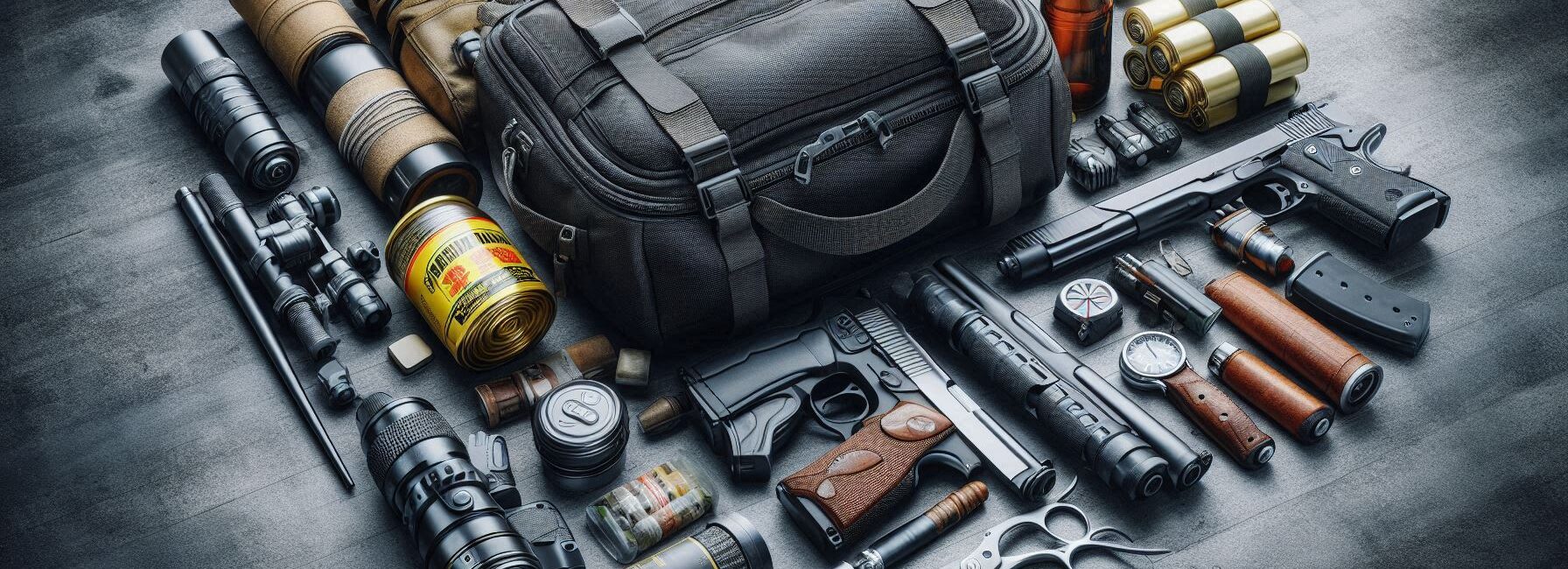Please Note: This post may contain affiliate links. If you click one of them, we may receive a commission at no extra cost to you. As an Amazon Associate, I earn from qualifying purchases.
Last Updated on November 1, 2025 by Kevin Collier

Top Takeaways and Key Concepts
- Start with basic blocking and evasion techniques to build self-defense confidence.
- Learn quick strikes, elbow attacks, takedowns, and escape moves for close combat.
- Choose classes like Krav Maga or Brazilian Jiu-Jitsu for practical real-world skills.
- Practice with sparring partners and drills to strengthen muscle memory safely.
- Keep training consistent, patient, and fun to improve skill and confidence.
Let's talk about how to protect yourself. If you're in a tough spot, the last thing you want to do is think about what you ate for lunch. Oh, right? You want to feel like you're ready and sure.
Learning how to fight up close is like learning a fantastic dance. It's not enough to just swing your hands like a crazy animal. You're learning abilities that will actually aid you when you need them. You know a few moves, and then all of a sudden you think, “Not today, buddy!” That's the power of practice.
It doesn't have to be hard to get started. Look for a class where you may learn and have fun at the same time. It's all about having fun while you learn those vital skills. You might also meet some interesting people. Who doesn't like making friends while they're doing well?
Begin with a modest step. Blocking and evading are two simple techniques that can help a lot. Think of yourself as the main character in a movie. Do what you have to do. It sounds stupid, but it really does help. As you practice, you'll feel more at ease.
Just remember to keep it fun. Train hard, but don't forget to laugh when you trip. Everyone has bad days. Who knows? Just being yourself might make the class a lot more entertaining.
So, put on your shoes, get in the mood, and let's make self-defense feel like a fun adventure. You can do it!
Understanding Close-Quarters Combat: What Is It?

To start, let's talk about what we mean by “close-quarters combat.” CQC is all about protecting yourself when the bad guys get too close, like at a dance party that goes wrong. You know how people bump into you at weddings? Picture that, but with more excitement and less “I'm sorry!”
*** Shop for Survival Gear - Tools - Kits ***
Survival Gear - Bags and Backpacks - Knives - Boots/Footwear - Communication
Outdoor Cooking - Gloves - Hydration - Dry Boxes - Water Filtration Systems
Tents - Sleeping Bags - First Aid Kits - Multi-Tools - Flashlights - Fire Starters
Navigation - Survival Food - Night Vision - Headlamps - Stun Guns - Binoculars
In CQC situations, conflicts typically happen up close and personal, like when you're standing toe-to-toe with someone who plainly didn't have their morning coffee and is feeling extra feisty.
This means that standard martial arts tactics might not always work. Instead, we emphasize on quick strikes, effective takedowns, and getting away before anyone has a chance to ask questions.
It's interesting because learning CQC might also make you feel more confident. Knowing that you can protect yourself offers you peace of mind. Let's be honest, it's really nice to feel like a superhero every day!
How to Find the Right Training Program

Not all training plans are the same, by the way! Think about what kind of setting works best for you when looking for the perfect self-defense class.
Some people do better in regimented classes with formal techniques, while others like a more relaxed setting where they can learn by doing things wrong (and maybe even sparring with friends).
Check up martial arts studios or community centers in your area that offer classes in Brazilian Jiu-Jitsu or Krav Maga. These styles focus on real-world self-defense techniques that are useful in real-life scenarios. This is great if you want to avoid getting hurt in a fight.
Also, don't be afraid to look at online platforms! A lot of trainers now offer online classes, which lets you be flexible without giving up good teaching.
Make sure your Wi-Fi doesn't go out in the middle of a kick, because nothing says “unprepared” like buffering during a self-defense course.
Important Skills for Close Quarters

It's time to learn the most important skills now that you've picked your training program. I mean, it's fantastic that you know how to throw punches, but wouldn't it be better if they actually hit? Every defender should know these important moves:
1. Strikes: Quick jabs or palm strikes to weak spots (such the eyes or nose) can stop an attacker long enough for you to get away—or get the last piece of pizza later.
2. Elbow Strikes: When you're in a tight place and swinging your arms about could seem weird (or impossible), elbows are your greatest buddy! They are strong tools that can have a big effect without taking up a lot of room.
3. Takedowns: Knowing how to knock down an opponent quickly can help make sure they don't follow you home if things go wrong, which is always a good thing!
4. Escapes: The goal here isn't always to win; sometimes it's just to get away safely! Practice many ways to get away from grips or clutches so that you always have options, even if things go wrong faster than you thought they would.
Sparring: Testing Your Skills

Let's talk about sparring now that we're talking about putting skills to use. Think of these as practice runs where you get to know your classmates instead of fighting imagined enemies hiding behind bushes (which sounds dramatic).
Sparring is like play-fighting with rules that let you practice for real-life situations without putting yourself in danger.
You can learn how to handle pressure by playing regulated matches with partners who will push back just enough to not leave bruises that look like war scars from the Middle Ages.
But don't forget: safety comes first! Before you enter into battle mode, make sure to use protective gear and talk freely with your partner about how comfortable you are. No one wants their first sparring match to finish early because their knees hit one other by accident!
Drills that Help You Build Confidence
Overall, exercises are a great approach to not only get better at anything but also boost your confidence over time! Regular practice helps strengthen muscle memory so that reactions become second nature instead than something that needs to be thought about, like when you're under stress and trying to solve a tough arithmetic problem.
Think about doing solo exercises at home with pillows or bags standing in for opponents. Nothing screams “I'm ready” like letting off steam on unsuspecting cushions after a hard day!
Also, and this can't be stated enough, don't be afraid to give constructive comments during class; coaches love to see students who are willing to learn and develop just as much as they want to see funny mistakes (believe me!).
Conclusion: Keep Practicing and Stay Safe
Hey, before we finish, let's talk about how to train for close-quarters combat. It's all about being patient, right? You won't become a star right away. But that's fine!
It's like cultivating a plant. It takes time. It could be hard sometimes, like you just don't get it. That's very natural. No joke, even the finest fighters were once just starting out. You have to keep going, even when you want to give up.
And hey, your mood matters too! Don't lose your sense of humor. When you trip or forget a move, laugh at the messy things. It makes things easier and a lot more fun. When you're having fun, you'll learn faster. Keep it in mind!
It can actually assist to find some gloves or matting. Whenever you can, practice. Those little moments add up, even if you only have a few minutes. Every kick and punch matters. You may think of it as getting closer to being your own superhero.
You might be amazed at how strong and sure of yourself you'll get. Not only did you tackle a terrible issue, but you did it with elegance. You came, worked hard, and had a good time. That's something to look up to, right?
So, let's keep pushing forward, even if it's just a little bit at a time! You can do this!
Frequently Asked Questions
What skills should beginners focus on first in CQC training?
Start with blocking, evasion, and simple counter-strikes to build confidence before progressing to more advanced moves.
Are certain martial arts better for close-quarters combat?
Systems like Krav Maga and Brazilian Jiu-Jitsu emphasize real-world self-defense, making them highly effective for close-range encounters.
Do I need a partner to train close-quarters techniques?
Sparring partners help build timing and resistance, but solo drills still strengthen muscle memory and technique.
Why are drills important in CQC training?
Repetition builds automatic reaction speed, allowing the body to respond quickly instead of hesitating under stress.
What types of strikes work best up close?
Elbow strikes, palm strikes, and quick directed jabs are extremely effective in tight spaces where large movements are limited.
Is sparring safe for beginners?
Yes, if protective gear is used and both partners communicate clearly, sparring becomes controlled and safe while building real-life readiness.
How long does it take to become confident in CQC?
With consistent training and practice, noticeable improvement can happen in weeks, but mastery requires months or years of dedication.
Suggested Resources:
Self Defense Tips
https://www.selfdefense.com/self-defense-tips/
Krav Maga Worldwide
https://www.kravmaga.com/
Martial Arts Supplies
https://www.martialartssupplies.com/

Kevin Collier is a seasoned survivalist and expert in prepping and homesteading, contributing to WiseSurvive.com. With a deep-rooted passion for self-sufficiency and outdoor survival skills, Kevin shares practical advice, strategies, and resources to help individuals prepare for any challenge. His informative articles cover a range of topics, from essential survival techniques to sustainable living practices, empowering readers to thrive in any situation. Whether you're a novice or a seasoned prepper, Kevin's insights will inspire you to take charge of your readiness and build resilience for the future.




